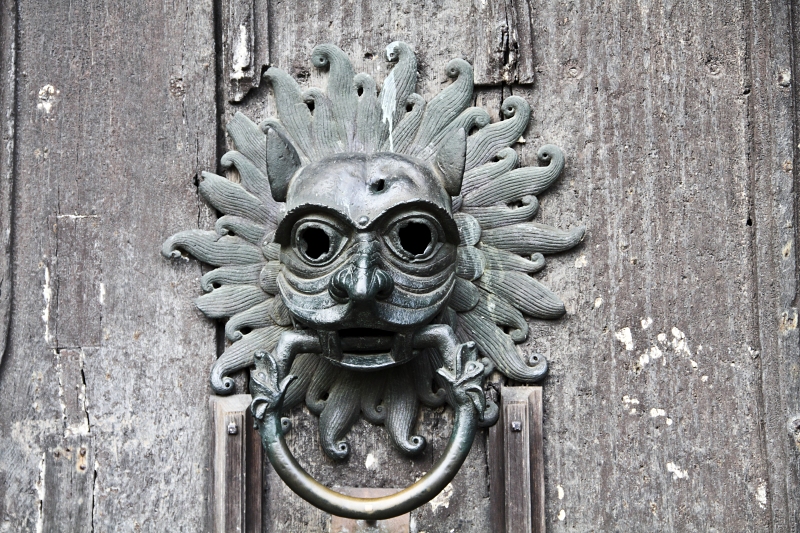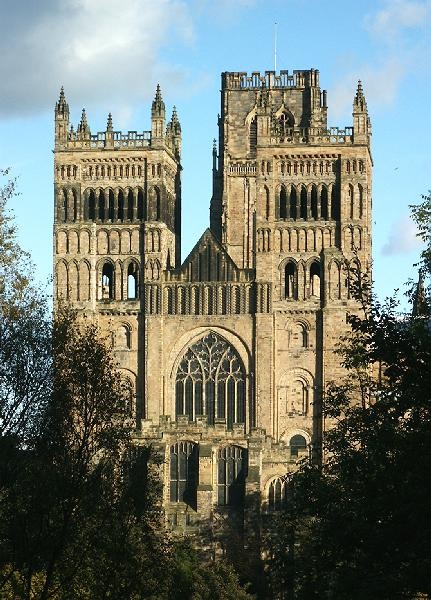
Durham Cathedral has fascinated me for some time, ever since I read the terms under which refuge was provided in the Middle Ages.
The bronze Sanctuary knocker on The North Door, which dates back to 1140, was used by criminals to draw the attention of watchmen who were in a chamber over the door. The criminal was granted the protection of the monastery for forty days, during which time he had to choose between a trial and voluntary exile.
If he chose the latter, he was escorted to a port, usually the Bishop's port at Hartlepool, wearing a badge in the shape of the cross of St. Cuthbert and carrying a rough wood cross tied together with rope. Once at the port, he was required to embark on the next ship that was due to set sail, regardless of its destination. Regardless of its destination! The mind boggles.
Entering through a passageway next to this door, we step inside the Cathedral and all of its splendor: the ancient and modern stained glass, the wonderfully ornate columns and choir stalls, and the marble mosaic floors. I am particularly impressed by these as I recognize several quilt patterns all perfectly produced centuries ago in so many muted shades of gleaming marble.
Towering organ pipes seem to be around every corner and they begin to resonate marvelous music, as the organist practices. The Venerable Bede's crypt is here and St. Cuthbert's as well. He was buried holding the head of St. Oswald, in whose tea room I had lunch hours before. The pulpit has more inlaid mosaic marble designs over which I ponder in wonder. The South Transept holds a magnificent clock, dating from the end of the 15th century, which shows not only the time of day, but also the day of the month and the phases of the moon.
Leaving the interior of the Cathedral, we stroll around the cloister, from which the West Tower can be seen rising regally into the sky. There are display boards lining the walls of the cloister which have pictures and information about the many manuscripts, missals and illuminated Gospels which are housed in the library here. Unfortunately the library may only be viewed by prearrangement. Also not accessible at this time is The Treasures of St. Cuthbert exhibition which includes remains of the coffin in which St. Cuthbert's body was placed in 698. Next trip, I tell myself again, smiling.
Back out into the warm afternoon sunlight we wander, walking to the Prior's Kitchen nearby; a round structure adorned with gargoyles. These gargoyles look particularly distressed by indigestion. Through the cobbled streets we stroll, over "sleeping policemen" (speed bumps), but there is no traffic, either pedestrian or automotive, in this quiet residential area behind the Cathedral.
Winding through the streets we find ourselves in a square where we discover an enormous bronze statue, green with verdigris. It's the Jolly Green Giant! No, it's the 3rd Marquis of Londonderry, astride his steed and looking quite dapper in his military uniform sitting before St. Nicholas' Church.
We have wound our way back to the multilevel car park where we wander around the many levels, discussing where we left the car. It takes us quite a while to find it but soon after, we are away and heading north again on the A1. It has grown quite late, and once again, I am appreciative of the hours of daylight here. We have time to fit in one more stop before calling it a day.

The Cathedral Church of Christ, Blessed Mary the Virgin and St Cuthbert of Durham, commonly known as Durham Cathedral, is a cathedral in the city of Durham.
Durham Cathedral holds the relics of Saint Cuthbert, transported to Durham by Lindisfarne monks in the ninth century, the head of Saint Oswald of Northumbria, and the remains of the Venerable Bede. In addition, its library contains one of the most complete sets of early printed books in England, the pre-Dissolution monastic accounts, and three copies of the Magna Carta.
The present cathedral was designed and built under William of Calais who was appointed as the first prince-bishop by King William the Conqueror in 1080. Since that time, there have been major additions and reconstructions of some parts of the building, but the greater part of the structure remains true to the Norman design.
Read more about Durham Cathedral at Wikipedia.